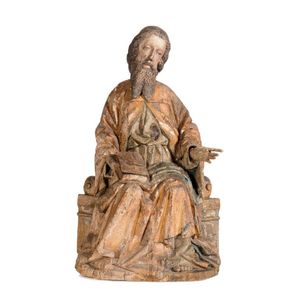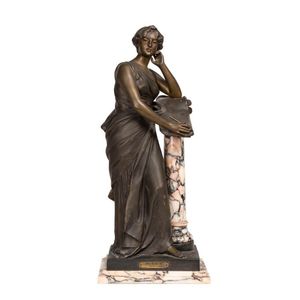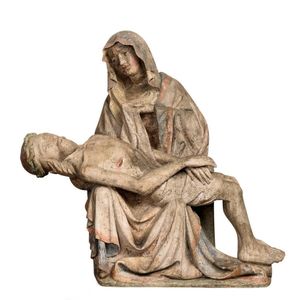A carved stone polychrome decorated figure group of the Pieta, possibly lower Austria, mid 15th century. This polychrome limestone sculpture represents the Pieta, in which the Virgin Mary cradles the dead body of her son. While the most famous example of this image type is the sculpture by Michelangelo in St Peter?s Basilica, the subject is derived from northern examples and was adopted quite late in Renaissance Italy. The Pieta, also referred to as Vesperbild, first appeared in German sculpture in around 1300 where early images often show the body positioned vertically, similar to depictions of the Deposition from the Cross, and also draw attention to the wounded, emaciated body. As the subject became more widespread, varied iconographies emerged. The type we see in this work, where Christ?s body lies horizontally across his mother?s lap, probably developed first in France. This image, which became especially popular, draws a symbolic connection between the lap of the Virgin and the Church altar on which, according to Catholic doctrine, the Eucharistic body of her son lies. The image therefore emphasized the salvific nature of Christ?s sacrifice and the redemptive power of the sacrament. Indeed, here the body is tilted up towards the viewer to accentuate the devotional focus on his humanity. The subject of the Pieta probably derived from mystical and popular devotional writings where events in between those described in the Gospels are imagined, suggesting an insight into the human, emotional responses of holy figures. Here the notion of Mary?s response to the death of her son and her cradling of his body before he is entombed is articulated with great sensitivity. Mary supports her son?s head with her right hand, while her left holds the edge of her cloak at her chest, suggesting that she is about to wipe her tears (as she is shown doing in numerous other Pieta sculptures). The faces of the figures are especially beautiful; Christ?s is gentle and relaxed while the Virgin?s subtly but very effectively suggests her sorrow. She looks not at her son, as is the norm for Pieta imagery, but to the distance; a detail that invests the image with a more meditative and poignant tone. As the sculpture is relatively well finished at the back and has a carved out section at the lower rear where it was anchored, it seems possible that it was originally positioned on a tomb. The subject probably, therefore, was intended to comfort the grieving. The composition of the figures demonstrates the extraordinary skill of the artist. It appears entirely natural, even ?though in reality such a grouping would likely be awkward and unfeasible.
You must be a subscriber, and be logged in to view price and dealer details.
Subscribe Now to view actual auction price for this item
When you subscribe, you have the option of setting the currency in which to display prices to $Au, $US, $NZ or Stg.
This item has been sold, and the description, image and price are for reference purposes only.
- Polychrome - Made or finished in many colours. For furniture, it is used to indicated a painted finish.
This item has been included into following indexes:
-
religious objects, Christian




